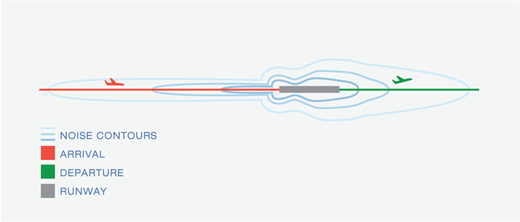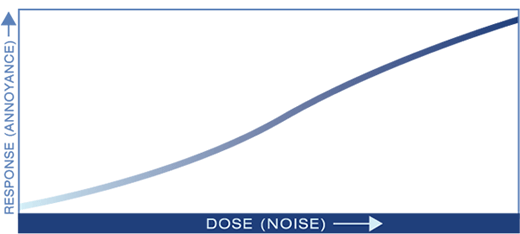FAA History of Noise
- Uses for Noise Thresholds
- Use of Annoyance as a Measure of Community Response to Noise
- Current Policy Informed by Dose-Response
Since the mid-1970's, the number of people exposed to significant aviation noise exposure in the U.S. has declined from roughly 7 million to just over 400,000 today. At the same time, the number of enplanements (each enplanement equals one person flying on a single commercial flight) has increased from approximately 200 million in 1975 to over 850 million today. In 1975, one person on the ground experienced significant noise exposure for every 30 enplanements, compared to today where more than 2100 enplanements are flown for every person on the ground experiencing significant noise exposure.
The single-most influential factor in the decrease in exposure to aviation noise was the transition to quieter aircraft. Following the framework established by 14 CFR Part 36, the FAA has adopted increasingly stringent noise certification standards for new aircraft. These certification standards combined with the development of new technology by aircraft and engine manufacturers; investments by U.S. airlines in newer, quieter aircraft; and mandates by the FAA and the U.S. Congress to retire older, noisier aircraft have all worked to reduce the areas around airports experiencing significant noise levels.
Today's civilian aircraft are quieter than at any time in the history of powered flight and the FAA, aircraft manufacturers, and airlines, continue to work to reduce aircraft noise at the source.
A second major factor in decreasing exposure to aviation noise has been the cooperation among airports, airlines and other aircraft operators, state and local governments, and communities to reduce the number of people living in areas near airports exposed to significant levels of aircraft noise. Through airport noise compatibility planning, local jurisdictions are encouraged to make local planning and zoning decisions that prevent new residential development in areas exposed to significant levels of aircraft noise.
Subject to eligibility requirements, the FAA also issues grants through the Airport Improvement Program (AIP) to airport operators and units of local government to fund projects to sound-insulate homes, schools, and healthcare facilities. Click on the AIP link above for further information on the AIP program.
Noise Contour Map

Uses for Noise Thresholds
The FAA uses the DNL metric and the 65dB noise threshold to make policy assessments in three primary areas:
- Setting the FAA's noise goal for reducing the number of people exposed to significant noise around U.S. airports
- Establishing the level of aircraft noise exposure below which residential land use is compatible, as defined in the Aviation Safety and Noise Abatement Act of 1979 (ASNA) and 14 CFR Part 150
- Establishing the level of aircraft noise exposure below which noise impacts of FAA actions in residential areas are not considered "significant" under The National Environmental Policy Act of 1969 (NEPA)
The threshold of significant aircraft noise exposure and the FAA's noise goal
In 1976, the Secretary of Transportation and the Administrator of the FAA issued the Aviation Noise Abatement Policy (ANAP), the first comprehensive aviation noise abatement policy in the U.S. In defining the "aircraft noise problem," this policy characterized aircraft noise exposure of DNL 65 to 75 dBA in residential areas as "significant" and DNL 75 dBA or more as "severe," and related these noise exposure levels to previously used interpretations of expected community actions based on case studies.
The ANAP also identified DNL 65dBA as the noise exposure level above which aircraft noise "create[s] a significant annoyance for most residents," but it did not provide any additional information supporting this characterization.
Since the issuance of the ANAP, the FAA has used the DNL 65 dBA threshold as the basis for its "noise goal" of reducing the number of people exposed to significant aircraft noise around U.S. airports.
Threshold of residential land use compatibility under the Aviation Safety and Noise Abatement Act
The Aviation Safety and Noise Abatement Act of 1979 (ASNA) was enacted in February 1980 to provide assistance to encourage airport operators to prepare and carry out noise compatibility programs, among other purposes. ASNA required the FAA to promulgate regulations to meet three key requirements:
- Establish a single, uniform, repeatable system for considering aviation noise around airport communities.
- Establish a single system for determining noise exposure from aircraft, which takes into account noise intensity, duration of exposure, frequency of operations, and time of occurrence.
- Identify land uses which are normally compatible with various exposures of individuals to noise.
To implement the requirements established under ASNA, the FAA then published 14 Code of Federal Regulations (CFR) Part 150, more commonly known as "Part 150."
Adopting Federal Land Use guidelines established in 1980 by the Federal Interagency Committee on Urban Noise (FICUN), Part 150 defines land use compatibility guidelines for aviation noise exposure. These guidelines consider land use compatibility for different uses over a range of DNL noise exposure levels, including the adoption of DNL 65 dBA as the limit for residential land use compatibility. As stated in the 1981 Federal Register Notice announcing Part 150, FAA's goal is one of "reducing substantially the number and extent of noise sensitive areas in the vicinity of airports that are subject to significant noise exposure."
In addition to the FAA, other federal agencies like the U.S. Department of Housing and Urban Development and the U.S. Department of Veterans Affairs use Federal Land Use guidelines in implementing their programs. They are guidelines only because the Federal government does not regulate land use. While they are also used by many state and local jurisdictions for planning and development purposes, these jurisdictions have discretion to adopt their own lower local guidelines for land use and zoning purposes. They also have ultimate responsibility for determining the acceptability of land uses at particular noise levels.
The DNL 65 dBA land use compatibility guideline for residential and other land uses in Part 150 has also formed the basis of eligibility for noise mitigation funded with Airport Improvement Program (AIP) grants, Passenger Facility Charge (PFC) revenues and/or airport revenues. For example, if a home or school experiences noise levels greater than DNL 65 dBA, then it may be eligible for sound insulation. Further information on existing sound insulation eligibility requirements can be found here on the FAA's website.
Threshold of significance for noise impacts under the National Environmental Policy Act
Separate from the FAA's role and authority to encourage airport noise compatibility planning under ASNA, the National Environmental Policy Act (NEPA) requires federal agencies to consider the impacts of their proposed actions on the environment. If a proposed federal action would significantly affect the environment, then NEPA requires the agency to prepare an Environmental Impact Statement (EIS). In its policies and procedures implementing NEPA, the FAA has exercised its discretion to specify DNL 65 dBA as the "significance threshold" for the noise effects of its actions. FAA further defines a "significant impact" due to noise as any location exposed to noise greater than DNL 65 dBA and experiencing a 1.5 dBA or greater increase in noise due to an action.
The FAA's adoption of DNL 65 dBA in the NEPA significance threshold was based on the "significance" of aviation noise exposure at or above that level, as described in "general guidelines for noise compatibility" and reflected in the Part 150 land use compatibility guidelines. Accordingly, the NEPA significance threshold applies only in noise sensitive areas (e.g., residential, schools, health care facilities) where the Part 150 guidelines are relevant to the land use.
Use of Annoyance as a Measure of Community Response to Noise
Social surveys can be conducted to determine the level of annoyance resulting from different noise sources, including aviation noise. Annoyance is a summary measure of the general adverse reaction of people to noise that causes interference with speech, sleep, the desire for a tranquil environment, and the ability to use the telephone, radio, or television satisfactorily. The results from annoyance surveys can then be used to better understand how people respond to different levels of noise exposure.
This relationship can be represented by what is called a dose-response curve. A dose-response curve is a graphical representation of the relationship between an exposure and an impact. In the case of aircraft noise exposure the dose is the amount of aircraft noise experienced and the response is the reported level of annoyance. Not surprisingly, as the "dose" of noise increases, the "response" of people annoyed also increases.

Current Policy Informed by Dose-Response
The noise thresholds used for current FAA noise policy are informed by a dose-response curve created in the 1970's known as the "Schultz Curve." Based on the data available at the time, the Schultz Curve provided a useful method for representing the community response to noise.
In 1992, the Federal Interagency Commission on Noise (FICON) reviewed all of the relevant information, including an updated Schultz curve. As stated in the 1992 FICON report, the DNL annoyance relationship depicted on the Schultz curve "is an invaluable aid in assessing community response as it relates the response to increases in both sound intensity and frequency of occurrence. Although the predicted annoyance, in terms of absolute levels, may vary among different communities, the Schultz curve can reliably indicate changes in the level of annoyance for defined ranges of sound exposure for any given community." While the validity of the dose-response methodology used to create the Schultz curve remains well supported, its underlying social survey data is now more than 40 years old.
To better understand whether changes to the dose-response relationship have occurred, the FAA has completed a national survey to measure changes to public perception to aircraft noise. The survey, which includes responses from over 10,000 people living near 20 representative airports will be used to create an updated national dose-response curve. Additional information describing the survey, including a description of the methods used to collect the data as well as a summary of its findings will be provided in future sections of this website.
